IER Activity Log 2019
February 7, 2020 We held IER seminar
| Date | February 7, 2020 |
The Institute of Environmental Radioactivity (IER) regularly holds research results reporting by faculty members as “IER seminar”, which aims to facilitate the communication among the faculty members and to progress their researches. In the 6th regular IER seminar of this fiscal year, eight master’s students of the Graduate School of Symbiotic Systems Science and Technology who entered in 2019 made presentations, and there were 24 attendees.
Master's students made oral presentations in English about their research results so far on their study. After the presentation, many comments were made not only by their supervisors but also other researchers and students from different fields of research. The students seemed to reflect on their future research plans with the comments obtained at the seminar.
Each research topic is shown below.
| Title | “Accumlation of radioceaesium in bryophytes”(Chieko Otsuki) “Internal exposure of the residents in cancelled evacuation-zone by self-consumed crops”(Mihoko Kikuchi) “Detection of 60Co released from the 2011 Fukushima Daiichi Nuclear Power Station accident”(Yusuke Okisawa) “Studies on the effective dose for public based on air dose rate”(Yuya Endo) “Temporal variation in 137Cs in the Niida river catchment during rainstorm events”(Takuya Niida) “Evaluation of Vegetation Index in Abukuma River Basin for Estimation of soil erosion”(Edea Loa) “Seasonal fluctuation of Cs-137 concentration and water quality in Abukuma river revealed by long-term monitorning”(Shota Moritaka) “Radiocesium concentration s in experimentally cultured carp, other fish, and sediments of an irrigation pond in Koriyama City”(Misaki Usuki) |
Active communication among students and teachers were made.
January 31, 2020 13th Dialogue meeting was held at Nihonmatsu City.
IER held the 13th dialogue meeting in Namie Town. IER has been holding these meetings since 2016, in order to feedback our research results to local communities.
details: CLICK
January 24, 2020 12th Dialogue meeting was held at Kyoto
IER held the 12th dialogue meeting in Namie Town. IER has been holding these meetings since 2016, in order to feedback our research results to local communities.
details: CLICK
December 26, 2019 We held IER seminar
| Date | December 26, 2019 |
| Presenter | Director Hirofumi Tsukada Associate professor Ismail Rahman Project assistant professor Hiroko Ishiniwa Project professor Vasyl Yoschenko |
| 演題 |
1)Activity concentrations of 137Cs in irrigation water and pore water collected from experimental paddy field in Okuma and related factors.(Tsukada) 2)Study of Ex-situ Remediation of Radionuclide Contaminated Matrix(Ismail) 3)Biodosimetry Dose estimation of wild animals(Ishiniwa) 4)Progress in our forest studies in Fukushima and Chernobyl(Yoschenko) |
The Institute of Environmental Radioactivity (IER) regularly holds research results reporting by faculty members as “IER seminar”, which aims to facilitate the communication among the faculty members and to progress their researches. In the 5th regular IER seminar of this fiscal year, Director Hirofumi Tsukada, Associate
professor Ismail Rahman, Project assistant professor Hiroko Ishiniwa, and Project professor Vasyl Yoschenko gave a talk and there were 26 attendees.
Director Tsukada and Associate professor Ismail, who conduct research in the field of Speciation Radiochemistry, made a presentation on their findings from the chemical point of view on conditions for radiocesium to be adsorbed in a substance or to be dissolved into a liquid. Participating researchers made questions about the applicability of the analytical methods in this field to other fields of research. Project assistant professor Ishiniwa talked about the effects of low-dose and long-term exposure on the wild boars and mice. Part of this report was also presented at the Fukushima University Research and Regional Collaboration Meeting held on Saturday, December 14, with the title of "放射線汚染地域で生きる野生動物の現状(Current Status of wildlife in radiation contaminated areas)". Project professor Yoschenko, who has started two bilateral projects this year, presented the results so far on the radiocesium dynamics in forests and more.
(Left)Director Tsukada (Right) Associate Prof. Rahman.
(Left) Project Assistant Prof. Ishiniwa (Right) Project Prof. Yoschenko.
December 5, 2019 We held IER seminar
| Data | December 5, 2019 We held IER seminar. |
| Presenter | Project researcher Tsutomu Kanasashi Associate professor (Adjunctive) Tsugiko Takase Project professor Mark Zheleznyak |
| 演題 |
1)Radiocesium transfer from riparian forest to headwater stream ecosystem(Kanasashi) 2)Interaction of radiation and materials: Application of gamma-ray detector(Takase) 3)Distributed modeling of radionuclide transport in watershed – river systems of Chernobyl and Fukushima regions(Mark) |
The Institute of Environmental Radioactivity (IER) regularly holds research results reporting by faculty members as “IER seminar”, which aims to facilitate the communication among the faculty members and to progress their researches. At the forth regular IER seminar of this fiscal year, Project
researcher Tsutomu Kanasashi, Associate professor (Adjunctive) Tsugiko Takase, and Project
professor Mark Zheleznyak gave a talk and there were 18 attendees.
Project researcher Kanasashi, who studies the movement of radioactive cesium in forests and mountain streams, attended the seminar for the first time as a presenter after his arriving at IER in September, and talked about his research so far and future plans in the SATREPS project. Associate
professor Takase gave an overview of her research from educational perspectives for the graduate students. Project
professor Zheleznyak focused on the results of the SATREPS project, which he will present at an international conference in the United States in December.
(Left) Project Researcher Kanasashi. (Right) Associate Professor (Adjunctive) Tsugiko.
(Left)Project Professor Zheleznyak.
November 29, 2019 We held IER special seminar.
| Date | November 29, 2019 |
| Presenter | Dr. Marcus Grzechnik (the Australian Government's primary authority on radiation protection and nuclear safety) |
| Title | Environmental Radiation Protection in Australia - An ARPANSA perspective |
Dr. Marcus Grzechnik from the Australian Government's primary authority on radiation protection and nuclear safety (ARPANSA) visited the institute of Environmental Radioactivity (IER). ARPANSA is an Australian government agency that conducts research on radiation protection and the safe use of nuclear energy, and Dr. Marcus is the director of Monitoring & Emergency Response Section. Taking the opportunity of his visit, we had him as a speaker at the IER special seminar and 16 people attended it.
At the beginning of the talk, Dr. Marcus explained about the organizational structure of the national government for environmental issues, and then mentioned the problems related to radioactivity that Australia has had with introducing the efforts ARPANSA has made to understand the potential effects of radiation on humans and environment. The researchers asked a variety of questions, such as the impact to Australia due to the accident at Fukushima, and Dr. Marcus answered that they haven’t find any danger to human health in their analysis.
Dr. Marcus talking at the seminar.
November 26, 2019 We held IER special seminar
| Date | November 26, 2019 |
| Presenter | Visiting professor Michio Aoyama (Univ. Tsukuba) Senior researcher Daisuke Tsumune(The Central Research Institute of Electric Power Industry) Professor Yusuke Uchiyama(Kobe University) Igor Brovchenko, Deputy Director(Institute of Mathematical Machine and System Problems of National Academy of Sciences of the Ukraine) Researcher Yutaka Tateda(The Central Research Institute of Electric Power Industry) Associate professor Toshihiro Wada(Institute of Environmental Radioactivity) Senior Assistant professor Yoshifumi Wakiyama(Institute of Environmental Radioactivity) |
| Title |
1)Mass balance and latest fluxes of radiocaesium derived from Fukushima accident in the western North Pacific Ocean and coastal regions of Japan.(Aoyama) 2)Impacts of direct release and river discharge on oceanic 137Cs derived from the Fukushima Dai-ichi Nuclear Power Plant accident.(Tsumune) 3)Nearshore transport of suspended radiocesium in the Fukushima coast derived from Niida River during Typhoon Wipha in fall 2013.(Uchiyama) 4)Lagrangian modeling of the radionuclide transport in marine environment”(Brovchenko) 5)Reconstruction of radiocesium level in sediment off Fukushima: Simulation analysis of bioavailability using parameter derived from observed 137Cs concentrations.(Tateda) 6)Radiocesium contamination of fish in river and pond environments near the Fukushima Daiichi Nuclear Power Plant.(Wada) 7)Temporal variations in 137Cs concentration in river waters under high-flow conditions.(Wakiyama) |
We jointly held an IER special seminar with the Central Research Institute of Electric Power Industry (CRIEPI). The seminar title was “A lagrangian model analysis of spatiotemporal particle behavior for radiocesium and marine food chain transfer” and seven presenters, including Igor Brovchenko invited from Ukraine by CRIEPI, made presentations.
The term “a lagrangian model” included in the title is a technique for simulating the behavior of particles or fluids, which plays an important role in the field of modeling for dynamic prediction. Presentations on other achievements were also made including the dynamics and radionuclides behavior of water in the ocean and river, based on various themes from dynamic analysis based on field surveys to future prediction by model construction. The participants actively exchanged their views across their research areas.
Many researchers participated and had active discussions.
November 7, 2019 We held IER seminar.
| Deta | November 7, 2019 |
| Presenter | Dr. Mikhail Komissarov(Ufa Institute of Biology of the Russian academy of science) Professor Konoplev Alexei Senior Assistant Professor Shigekazu Hirao |
| Title |
1)Soil erosion researches in various lands.(Mikhail) 2)Long-term dynamics of radionuclides in rivers and lakes: Fukushima and Chernobyl. Progress of ongoing projects.(Alexei) 3)Investigation of Tritium behavior in Okuma.(Hirao) |
The Institute of Environmental Radioactivity (IER) regularly holds research results reporting by faculty members as “IER seminar”, which aims to facilitate the communication among the faculty members and to progress their researches. At the third regular IER seminar of this fiscal year, Professor Konoplev, Senior Assistant Professor Hirao and Dr. Komissarov from Russia gave presentations. There were 23 attendees.
Dr. Komissarov, who was invited by Prof. Konoplev from Ufa Institute of Biology of the Russian academy of science for research activity, is a soil scientist studying on erosion caused by snowmelt water, irrigation, and so on. At the seminar Dr. Komissarov gave a talk on his researches so far conducted in Japan, Russia and Austria. Prof. Konoplev talked about his comparative study on the impact on river water by the nuclear accident in Chernobyl and Fukushima, which has been conducted with the support by external funds. Then Senior Assistant Professor Hirao followed, and explained the progress of research to clarify the environmental dynamics of the radionuclide, focusing on tritium, released from the accident of nuclear power plant in Fukushima.
(Left)Dr. Komissarov (Right) Professor Konoplev
(Left)Senior Assistant Prof. Hirao. (Right)Prof. Konoplev facilitated the seminar.
October 25, 2019 Australian Journalists visited IER.
Three journalists from AESA film, an Australia-based film production company, visited the Institute of Environmental Radioactivity (IER) for filming a program. Their new program is a documentary on the major nuclear power plant accidents occurred in Chernobyl and Fukushima with the comparison between the two regions, in which they try to portray and describe what happened in the local areas and how the people cope with the situations.
During the two-week stay, they closely accompanied the researchers to many research activities such as field surveys and seminars. The director of the company, Dr. Allen Dobrovolsky, he himself has a career as a scientist, eagerly asked questions to the researchers of IER in each interview. They all are originally from Ukraine and it would be also interesting to see how their view for the current situation in Fukushima will be reflected in the film.
For more details of AESA films, Click here.
(Left)Filming team joined observation tour with Mr. Nasvit.
(Right)Interview with the Associate prof. Wada at his laboratory.
(Left)Water sampling by project associate prof. Takata at a port in Tomioka.
(Right)They admired the beauty of costal view in Tomioka Town.
(Left)Interview with Prof. Alexei during his field research in the Evacuation Zone.
(Right)Aerial filming by drone with a permission.
October 18-23 , 2019
The former deputy of State Agency of Ukraine on Exclusion Zone Management visited IER【2】
■18 October Visiting municipalities influenced by the nuclear accident.
The observation tour was conducted in Namie Town, Futaba Town, and Okuma Town to learn about the situations and changes in each town, including the things right after the disaster, evacuation life afterward, and the role of town after the evacuation order was lifted with the visions for new industries.
At the Namie Town, the Deputy Mayor Sato explained the situation around that time. Because the evacuation order had been issued, it became impossible to search for missing people by tsunami, which means there were lives that could be saved if there was no nuclear accident. There were a lot more difficulties such as figuring out the contact information of evacuees. Current population is 6% before the earthquake, but given that 11.8% want to return as a survey result, Namie Town is promoting infrastructure and town development without depending on nuclear power plants. Continuous support seems to be necessary for the town to keep moving forward in having their people return and in recovery.
In Futaba Town, Deputy Director Nakazato guided us in the town. The Nakano area located on the east side of Route 6 is now the “evacuation order cancellation preparation zone,” where the as a reconstruction industry base
with locating the operation of local businesses is being promoted. Local business are planning to locate on the area. Then we moved to the front of JR Futaba Station. This area is designated as “Specified Reconstruction and Revitalization Base,” where decontamination and dismantling are in progress. With the reopening of the station in the end of this fiscal year, the evacuation order will be lifted on the road to Nakano area and the surrounding difficult to return zone will be open to access.
In Okuma Town, Deputy Mayor Ishida delated on the communications with the government and TEPCO immediately after the earthquake, as well as the actions they took at that time. We understood the sense of urgency they faced at the time and that they were forced to evacuate in the confusion. From the view of town planning, town-owned houses have built in the Okawara district where the radiation dose is low, while Ono Station district is also planned to work on reconstruction being positioned as a decommissioning work-related area within the plan of “Specified Reconstruction and Revitalization Base. The town wants to promote the return of people with improving the situation so that they can do so when they want to.
All three towns welcomed Mr. Nasvit with courtesy and friendly atmosphere. Mr. Nasvit seemed to have recalled his own experiences at the Chernobyl accident, and made thoughtful comments and questions with hopes of continued friendship.
(Left)Mr. Nasvit handed a Ukrainian souvenir to Mr. Sato, Deputy Mayor of Namie Town
(Right)Deputy Director Nakazato (left) guided around Futaba Station
Mr. Nasvit handed a Ukrainian souvenir to Mr. Ishida, Deputy Mayor Ishida of Okuma Town
■23 October Holding a seminar at Kyoto University
With a big assistance and arrangement by Dr. Tetsuji Imanaka and Prof. Tsutomu Ohtsuki, at Division of quantum beam material science, Kyoto University, a seminar was held at Kyoto University. Professors and students conducting researches in the related area joined and listened to the presentations by Mr. Nasvit.
He told about the damages by the accident at Chernobyl Nuclear Power Plant and the building which is currently under construction to cover the damaged reactor. Also, Project Prof. Zheleznyak at IER talked about differences on the effect of the accidents comparing Fukushima and Chernobyl.
The participants raised several questions and one of them told that he had a good chance to hear lectures to consider the future of Fukushima.
In addition to the activities above, Mr. Nasvit also visited Fukushima Daiichi Nuclear Power Plant during his stay. He will continue to assist SATREPS project as a coordinator and we work with to accelerate the project to give an effective suggestion to SAUEZM.
(Left)Dr. Imanaka introducing Mr. Nasvit(Right)Mr. Nasvit giving lecture at Kyoto University
October 17, 2019
The former deputy of State Agency of Ukraine on Exclusion Zone Management visited IER【1】
Mr. Oleg Nasvit, the former deputy of State Agency of Ukraine on Exclusion Zone Management (SAUEZM), visited Japan from 16 to 24 October. SAUEZM is one of the counterparts of our SATREPS project and it is an important purpose of the project to give a suggestion to SAUEZM regarding future plan of the exclusion zone (the area where is prohibited to enter due to the accident at Chernobyl Nuclear Power Plant). During his stay in Japan, Mr. Nasvit visited not only places in Fukushima Prefecture but also in Kyoto. Please check out the below for the details of his fruitful program.
■17 October Visit Fukushima Prefectural Centre for Environmental Creation and carp cultivation union, lecture at IER
The first destination of his program was Fukushima Prefectural Centre for Environmental Creation (CEC) in Miharu Town. CEC was established in 2016 by a collaboration of the three organizations; Fukushima Prefecture, Japan Atomic Energy Agency (JAEA), and the National Institute of Environmental Studies (NIES).
At the NIES section, presentations were made on the latest progress of environmental creation and waste management after the nuclear accident by members of each research team. Mr. Nasvit also explained about how they are managing wastes and exclusion zone in Chernobyl and there was an active discussion on how we should obtain consensus from local people, how we should effectively use exclusion zone, and so on.
He got explanation from JAEA and Fukushima Prefecture about their research and overview of CEC.
At the next destination, the carp cultivation union in Koriyama City, the head of the union and a Koriyama City officer told how they got damaged by the nuclear accident and harmful rumors after that. Mr. Nasvit seemed to be surprised hearing that people in the area still struggle with harmful rumors even though it has past 8 years after the accident. The lunch after observing cultivating pond was a full-course of carp dishes. Mr. Nasvit interestingly tasted carp cooked in Japanese style, saying that in Ukraine, where the sea is far away, carp is popular and people often eat it.
Moving back to IER, he gave a lecture about Ukrainian government policy on exclusion zone during SATREPS project at IER special seminar. After the lecture, each research team of the project shared their progress. As a lot of researchers are involved in the project, it was a very meaningful seminar to reconfirm their project goals.
(Left)Mr. Nasvit explaining the situation in Chernobyl
(Right)Mr. Nasvit giving souvenir form Ukraine
(Left)Observing carp cultivating pond
(Right)Enjoying carp full-course lunch
With SATREPS project members
October 16, 2019 We held IER special seminar
| Date | October 16, 2019 |
| Presenter | Professor Alexei Konoplev Doctor Ivanov Maxim, Researcher, Lomonosov Moscow State University Professor Kenji Nanba Senior Assistant Professor Yoshifumi Wakiyama Project Professor Mark Zheleznyak |
| 演題 |
1)General information about JSPS-RFBR Project and its progress so far(Konoplev) 2)Progress in research of Russian team and joint studies(Ivanov) 3)Studies of long-term dynamics of r-Cs in Abukuma River(Nanba) 4)Short-term changes of r-Cs concentrations in Abukuma river during the floods(Wakiyama) 5)Modelling of r-Cs transport in Abukuma River and Upa River basins(Zheleznyak) |
This IER special seminar was held to welcome Dr. Ivanov from Lomonosov Moscow State University, who is one of the collaborative researchers of the Japan- Russia bilateral project and has visited IER for its joint field/lab work and discussions.
With the title of “Assessment and prediction of sediment and radionuclide fluxes in river basin affected by severe nuclear accident”, the two years bilateral project has started in April 2018 under the initiative of Prof. Konoplev. One of the major goals of the project is to predict radionuclide behavior and migration in the Abukuma river with comparing r-Cs dynamics on the basins of Abukuma river and Upa river, both exposed to contamination by a nuclear accident.
The researchers have visited Japan and Russia each other for several times to accelerate the project. In the seminar, the researchers gave presentations to share their research progress so far with active discussions. Because it was just a few days after the Abukuma river was flooded in several areas due to Typhoon Hagibis, there was also a discussion about its effect.
Dr. Ivanov is going to join sampling at several sites in Fukushima prefecture and visit Fukushima nuclear power plant during his stay in Fukushima for nearly four weeks.
Through these activities in both Japan and Russia, the project members are aiming to produce more outcomes and make an achievement in publications and presentations in academic conferences.
Dr. Ivanov giving presentation about his research
October 11, 2019 IER researchers gave a talk at Hokkaido University
Three professors from the Institute of Environmental Radioactivity (IER) gave lectures to the master students of the Graduate School of Fisheries Science, Hokkaido University as part of their classes. There were more than 50 attendees not only the graduate students but the under graduates and faculty members as well.
Under the theme of “Radioactive effects on fish and impact on fishery attributing to the Fukushima Daiichi nuclear power plant accident and the current situation,” the first talk by Professor Tsukada began with an overview of the IER, our activities and progress in research on radioactivity. Then associate professor Wada and project associate professor Takata gave a talk about the impact by radiation on fishery from their viewpoint on “fish” and “ocean current” respectively.
After the lecture, the participants made some comments such as “my image of the radionuclides released to the ocean has become clear” and “situation was different from what I had imagined.” The professors said that they become aware a lot from their comments and enthusiastic learning attitude.
Prof.Tsukada giving a lecture. Hokkaido University is the alma mater of Prof.Tsukada and Prof.Takata.
October 10, 2019 We held IER seminar.
| Data | October 10, 2019 |
| Presenter | Associate Professor Toshihiro Wada Project Associate Professor Hyoe Takata |
| Title | 1)Factors affecting radiocesium contamination of freshwater fish distributed inside and outside of the designated evacuation zone(Wada)
2)Simultaneous observation of R-Cs from river to sea in the southern Fukushima(Takata) |
The Institute Environmental Radioactivity (IER) regularly holds research results reporting by faculty members as “IER seminar”, which aims to facilitate the communication among the faculty members and to progress their researches. At the second regular IER seminar of this fiscal year, Associate Professor Wada and Project Associate Professor Takata gave presentations. There were 14 attendees.
Associate prof. Wada has made publications showing that the radioactive concentration of fish in freshwater in Fukushima Prefecture is still relatively high. In this seminar, he reported the detailed research results that explain the factors. Project Associate Prof. Takata, in his first presentation at IER seminar, talked about his study on cesium concentrations in rivers and ocean in the south of Fukushima Dai-ichi Nuclear Power Plant that has been started after he joined IER.
(Left)Associate Professor Wada. (Right)Project Associate Professor Takata.
Discussion took place among the researchers about methodologies and prospects of future study.
October 8, 2019 Belgian researchers visited IER.
Mr. Robin Nauts, a researcher of the Belgian Nuclear Research Centre (SCK-CEN), and Dr. Jos Ruitynx, Vrije Universiteit Brussel, visited IER. From SCK-CEN, Prof. Horemans Nele also visited us in May for a kick-off meeting and sampling campaign as a starter of the bilateral joint research project with our professor Vasyl Yoschenko, and also made some presentations.
In this bilateral project, studies on the effects of radionuclides on plants, particularly on the Japanese red pine, have been conducted. Dr. Jos is not a member of this project, but she focuses on fungi associated with pine trees and has studied how radiation exposure of Japanese red pines affects symbiotic fungi. In this visit for a week, they conducted the field surveys at the various locations both in difficult-to-return zone and control site.
A filming crew from NHK (Japan Broadcasting Corporation) joined the field survey to film and interview the land owner of the observatory site in Tsushima and each researcher about the situations of the land and study. We will inform you the details of the TV program when it becomes available.
(Left)Mr. Robin having an interview during his research.
(Right) Dr. Jos Ruitynx(left) , Prof. Yoschenko(center) and Mr. Robin Nauts.
They went “mushrooming” with the support from land owner and mushroom specialist.
October 5, 2019
Prof. Takata gave a talk in “Fukushima Fish Festival” in Soma.
Project Associate Professor Hyoe Takata gave a lecture in an academic seminar of “Fukushima Osakana (literally fish) Festival” held in Soma City. This event has been held at various locations in Fukushima prefecture, with the purpose of making contributions to revitalization of fishery activities in Fukushima and making general public familiar with it. People can learn the current situation of fisheries in Fukushima through the familiar topics such as local food.
In the talk titled “Fish and The Marine Environment” at the seminar, Project associate prof. Takata firstly mentioned that the cesium concentration in the ocean has dropped to the level before the nuclear accident by 2018, then explained that the cesium concentration of marine products has also decreased. Project associate prof. Takata expressed the safety of fishery products from the scientific view point.
Project associate prof. Takata giving a talk.
September 26, 2019 We held IER seminar.
| Date | September 26, 2019 |
| Presenter | Project Researcher Yasunori Igarashi. Senior Assistant Professor Wakiyama. |
| Title | 1)Basin scale estimation of current and future water balance from streamflow time series at Chernobyl Exclusion zone.(Igarashi)
2)Temporal variations in particulate and dissolved 137Cs concentration in the Abukuma river water during floods(Wakiyama) |
The Institute Environmental Radioactivity (IER) regularly holds research results reporting by faculty members as “IER seminar”, which aims to facilitate the communication among the faculty members and to progress their researches. At the first regular IER seminar of this fiscal year, two young researchers, Project Researcher Igarashi and Senior Assistant Professor Wakiyama gave presentations.There were 12 atendees.
They both specialize in hydrology, which is the study on the movement of water in the environment in a broad sense such as rainfall, evaporation, river flow, and so on. The topic of researcher Igarashi was about the research at Chernobyl under the SATREPS project (What’s SATREPS?), and Prof. Wakiyama talked about his research conducted in rivers in Fukushima Prefecture, mainly in Abukuma River.
(Left)Project Researcher Igarashi. (Right) Senior Assistant Professor Wakiyama.
After the presentations, other IER professors made comments and questions for the following process on their studies.
September 11, 2019 Students from Kawauchi Junior High School visited us.
Six students from Kawauchi Junior High School in Kawauchi Village came to the Institute of Environmental Radioactivity (IER).
We explained the purpose of our research activities and how they are conducted, showing some pictures taken at sampling sites. The students carefully listened to our explanation especially when we talked about the importance of sharing correct information from a scientific perspective. We also introduced several research instruments so that the students can imagine how our activities are conducted.
Because all of the residents in Kawauchi Village were evacuated from their village for a while just after the disaster, the students experienced inconvenient evacuation life even though they were little kids. We hope that it was an opportunity for them to learn something new for the recovery of their village.
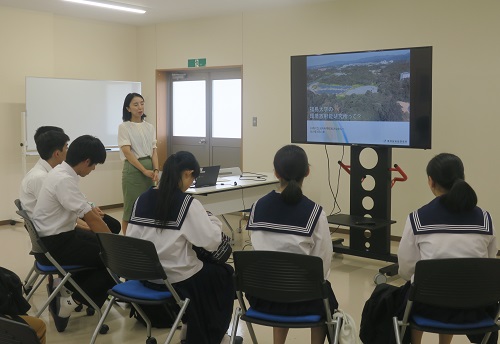
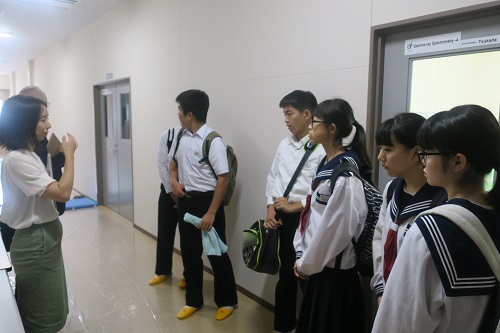
Students listening to explanations. They visited laboratories and looked at equipment such as large optical microscope.
September 5, 2019 Students from Hiwada Junior High School visited us.
Fifteen students from Hiwada Junior High School in Koriyama City came to the Institute of Environmental Radioactivity (IER).
At IER, we explained the role of the institute, and talked about radioactive materials that are dispersed following the accident of Nuclear Power Plant, and others that existed naturally in the environment. In the tour of the analytical laboratory, we introduced various instruments for research. Students were surprised to see a large device that is unfamiliar for them.


Students listened to explanations eagerly.
September 3, 2019 Students from Universities in Turkey visited us.
Fukushima University has participated in the project “Global Framework of Student Capacity Development for Resilient Agriculture and Food Production” promoted by Niigata University as a main institution in Japan,
and established the relationship with three universities in Turkey participating in the project, which are Ankara University, Ege University, and Middle East Technical University. This project is adopted into a program “Inter-University Exchange Project” by
Ministry of Education, Culture, Sports, Science and Technology (MEXT). With the background that Turkey and Japan (Niigata and Fukushima) are commonly exposed to various natural disastrous risks, while both are leading in agriculture, the aim of the project is
to combine and apply the knowledge that both countries have gained from the previous experiences and to foster global agricultural specialists with resilience to respond to various difficult situations in the future.
During the two-week visit program in Japan, Turkish students visited various places in Niigata and Fukushima prefectures to learn about the situation surrounding agriculture in the regions. At Fukushima University, Associate Professor Toshihiro Wada of IER and Associate Professor Kumpei Hayashi of Faculty of Food and Agricultural Sciences, explained the facilities and research outline. Some of the students looked to be motivated to study in Japan by the lectures, and it is expected that the mutual relationship will be enhanced through this project.
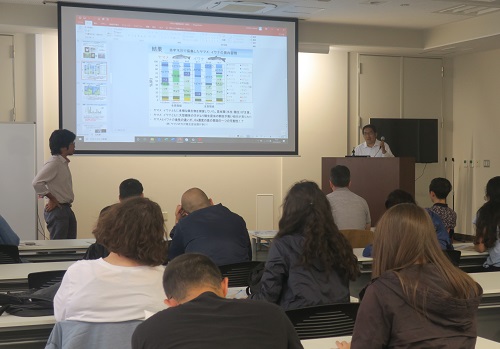
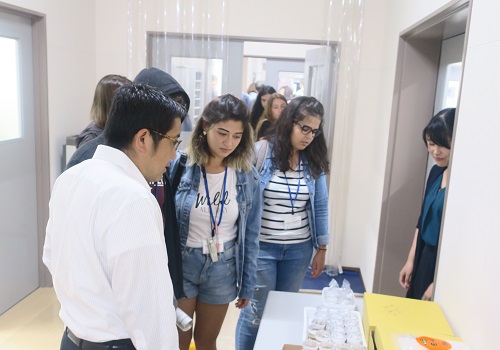
(Left)After presentations, students asked many question on their research.
(Right)Associate Prof. Wada gave them a tour of analytical laboratory.
August 30, 2019 Students from Adachi Junior High School visited us.
Forty students from Adachi Junior High School in Nihonmatsu City came to the Institute of Environmental Radioactivity (IER). They visited Fukushima University as an opportunity to know and experience a campus life by having a tour and looking around the university facilities.
At IER, we introduced the role of the institute along with explaining our research activities, and showed them various devices and equipment in the analytical laboratory tour. They looked into the microscope and taking notes while listening to the explanations with enthusiasm. We would be glad if the tour was helpful for them to understand what university is like and have a positive impression of it.
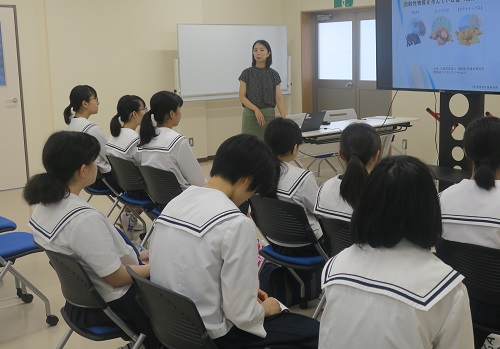
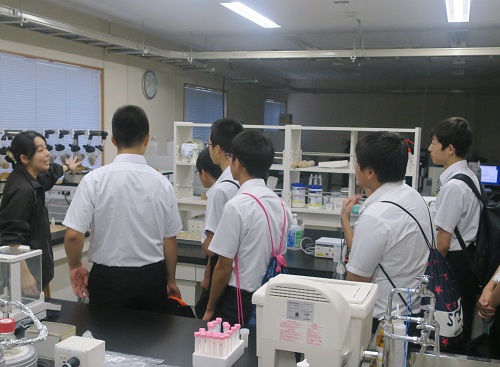
Students listening to explanations. Students observed a large optical microscope and other equipment.
August 28, 2019
Students from National Institute of Technology (NIT), Fukushima College (Fukushima Kosen)visited us.
Ten students from NIT Fukushima College visited the Institute of Environmental Radioactivity (IER).
NIT Fukushima College has been conducting a program entitled “Practice of Problem Solving Type Approach to Promote Understanding Reuse of Contaminated Soil“ as one of the subsidy programs of Ministry of Environment since April 2018. The main purposes of the program are to promote understanding of young people about contaminated soil, raise opinion leaders, and encourage communication between local residents and academics. In order to achieve these purposes,
the college offers students several activities such as visiting an interim storage facility, giving collaborating lectures with companies or government agencies, and so on. The students visited IER as a part of these activities to exchange opinions with students at Fukushima University.
Mr. Yui, a teacher at Fukushima College introduced the program at first. Then, the students had a lecture of research activities by the researchers at IER and had a tour to see the various equipment in the laboratory. The students at NIT Fukushima College also presented their own research activities. At the last of the day, they had a discussion with graduate and undergraduate students at Fukushima University on the theme “how to effectively explain about the research on contaminated soil and its results to the public”. Since the students were around the same age and studying in the similar research field, the discussion was very active and inspiring for both of them.

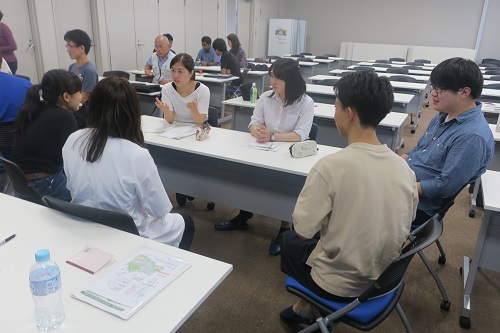
(Left)Students from Fukushima College observed Ge detector.
(Right)They had a discussion with students at Fukushima University.
August 19, 2019 We held a special IER seminar
| Data | August 19, 2019 |
| Presenter | Ph.D. student Rebecca Quelfield (Hannover University) |
| Title | A project to separate and measure radionuclides such as fission products in moss that were taken from evacuated or non-evacuated areas in Fukushima province. |
Ph.D. student Rebecca Quelfield, who has conducted research activities under an adjunctive researcher of IER, associate professor Yoshitaka Takagai from faculty of symbiotic system science, made a presenatation on her research activity. Ms. Rebecca is a Ph.D. student of Hannover University, Germany, visiting Japan and has studied in Japan from this June to August, as a fellow of JSPS Summer Program.
Ms. Rebecca has studied the radionuclides and its fate in mosses, and talked about her study activities during her stay in Japan. She particularly focused on the field surveys conducted in the surrounding area of the Fukushima Dai-ichi Nuclear Power Plant. She concluded her presentation with talking about her research plan following her study in Japan. Then there was an active discussion with professors, on the research methods and background of her study.

Ms. Rebecca talked about her research activities in Japan.
August 11, 2019
IER Open Day held in conjunction with Fukushima University Open Campus.
In conjunction with Fukushima University (FU) Open Campus, the Institute of Environmental Radioactivity (IER) opened its facility to the public and provided the analytical building tour as well as the mock lecture by IER teachers for high school students.
The IER Open Day was set as its first try on the same day of FU open campus, which was a good opportunity to make known our activities to and to communicate with the public. Consequently, a lot of visitors not only high school students but also their parents, and even schoolchildren. In addition to the regular activities for research output, such as the Annual Symposium and dialogue meetings, we would like to continue this activity in the future.


A fish tank keeps Ugui (Japanese dace) and Unagi (Japanese eel) in was displayed by the labo of Associate professor Toshihiro Wada, and Project Assistant professor Hiroko Ishiniwa was showing the skeletal specimens of mice.


Technical staff giving an explanation on equipment in the tour. (Right)
The documentary film was shown on the 6F of main building. The film was produced by Japan Desk Scotland, who has been focusing on Fukushima after the accident.

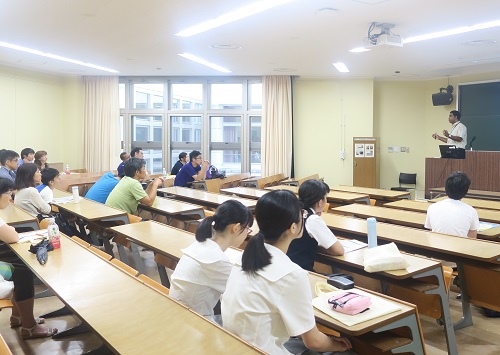
In the mock lectures, Project associate professor Hyoe Takata (left) talked about the relationship of ocean and redionuclides, and Associate professor Ismail Rahman (right) talked in English about his own carrier as a scientist.
July 30, 2019 11th Dialogue meeting was held in Namie
IER held the 11th dialogue meeting in Namie Town. IER has been holding these meetings since 2016, in order to feedback our research results to local communities.
details: CLICK
July 25, 2019 We held IER special seminar
| Date | July 25, 2019 |
| Presenter | Mariah Davis(CSU) Jian Zhang(CSU) Cameron Udy (CSU) |
| Title | 1)"Lifetime Dose Reconstruction in the Large Japanese Field Mouse Using Electron Spin Resonance (ESR)" (Mariah)
2)"Determination of Local Ecological Factors on Radiocesium Soil-to-Plant Transfers in Fukushima Forest Ecosystems" (Jian) 3)"Radiocesium fate and transport in soil-water environment in the proximity of the Fukushima Dai-ichi Nuclear Plant"(Cameron) |
Three students from Colorado State University, who have conducted research activities under the guidance of host researchers of the Institute of Environmental Radioactivity (IER), reported on their achievement of the two months research. In addition to IER faculty members and students, there were 26 attendees, including staff and students from other faculties, who have interacted with them during their stay in Japan.
Through the experiences of field surveys in Fukushima and measurement of collected samples, the students conducted their research within a limited period of two months. They introduced the equipment and methods used in each process of the research, explaining the difficulties and fails that led to their success. We could see their effort they made in an unfamiliar research environment for them.
After each presentation, many comments and questions were made by faculty members, which would be helpful for their future research after returning to the United States. Project Professor Vasyl Yochenko as a moderator remarked “Two-months stay is too short, but they made a great research progress with such a nice presentation.”
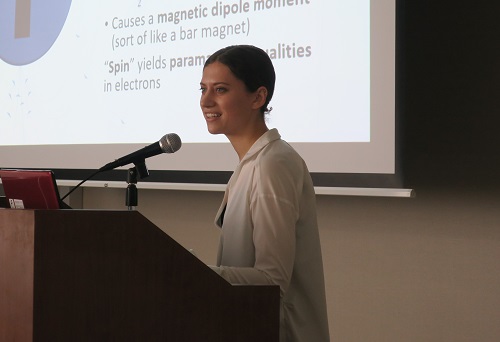
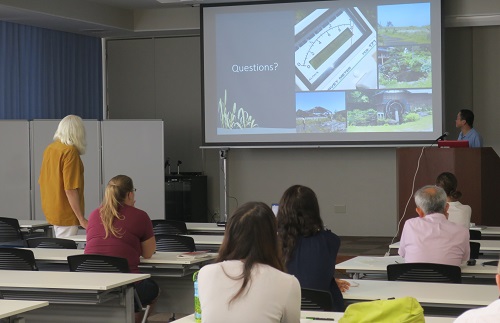

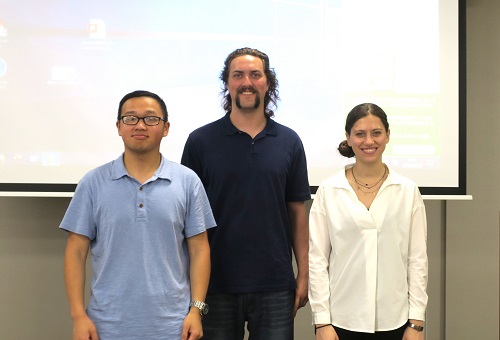
Three CSU students giving a presentation.
(From Left in the group photo)Jian Zhang, Cameron Udy, Mariah Devis.
July 24, 2019 MEXT officers and Fukushima city councilors visited IER
The officers of Ministry of Education, Culture, Sports, Science and Technology (MEXT), State Minister Tomoko Ukishima, Minister’s Secretariat Taishi Kaneshiro, and Deputy Minister Akira Tamagami, also the Fukushima city councilors Kyoto Ono, Zenji Goto, and Naoto Takagi visited Institute of Environmental Radioactivity (IER). They also observed the Faculty of Food and Agricultural Sciences of Fukushima University and its farm land in this visit.
Professor Hirofumi Tsukada, Director of IER, provided an overview of IER including the background of establishment and the research activities so far. Then IER technical staff gave them a tour of the analytical laboratory equipped with the various facilities and devices for research.
With mentioning the establishment of the master's program in graduate school started in April, Prof. Tsukada emphasized the importance of the environmental radioactivity research with the long-term perspective and enhancing education of future researchers in the field.
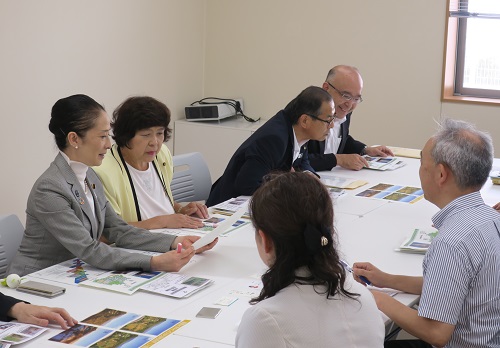
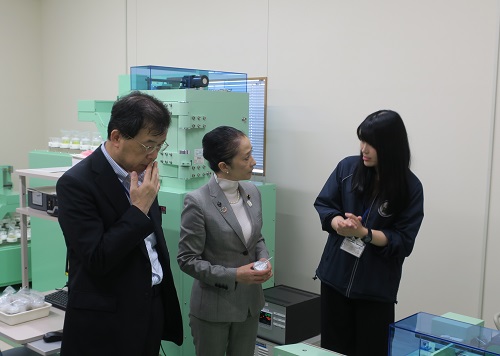
(Left) Ms. Ukishima, State Minister of MEXT (left), Ms. Ono city councilor (2nd from left), Mr. Goto city councilor (2nd from right, back), Mr. Takagi councilor (right, back)
(Right) Ms. Ukishima (middle), Mr. Tamagami, Deputy Minister (left)
July 17, 2019 Students from Vietnam and Fukushima-Vietnam Friendship Association members visited
Two students from Phuong Dong University (PDU) in Vietnam and three members of the Fukushima-Vietnam Friendship Association visited Fukushima University and the Institute of Environmental Radioactivity (IER).
The Fukushima-Vietnam Friendship Association, established in 1990, has been engaged in activities to contribute to mutual understanding between Fukushima and Vietnam, and has supported PDU students for a long time for their visit
to Japan. The two students will visit companies in Fukushima to learn Japanese culture and social customs in a three-week stay program.
From the top floor of IER, the landscape of “Satoyama”, a typical scenery of countryside, can be seen, but at the same time we see the area used for a temporary storage of radioactive waste from the decontamination work. IER staff explained the impact and present situation of Fukushima after the accident with showing those contrasting views. The visitors listened to us intently, while admiring the scenery of rich natural environment.


(Left)Phuong Dong University students getting the Director Tsukada’s greeting
(Right)Viewing the surrounding sceneries of IER
July 16, 2019 Minami-soma City Social Welfare Councils visited to IER
Twelve members of Minami-soma City Social Welfare Councils visited to IER. The Council is organized by people in the local community with the purpose of providing services and information to those who require and provide welfare. Since the Great East Japan Earthquake, they have also provided support for refugees.
After introducing the history and activities of IER by staff, Associate Professor Takata gave a brief explanation of his research. Soso area, which includes Minami-soma City, is also a region where the impact of the earthquake was enormous. They asked many questions about the circumstances of radiation effect in Fukushima. It is valuable and meaningful for us to know public questions and concerns and we would like to make use of them for our future activities.

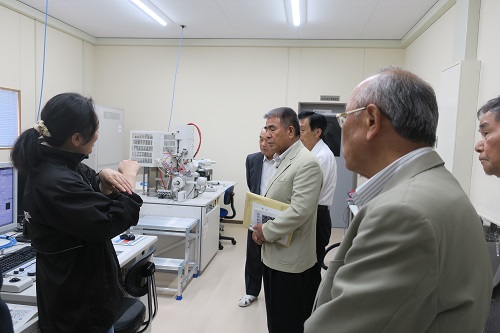
(Left)Project Associate Prof. Takata giving an explanation of his research.
(Right)Staff gave a laboratory tour.
July 11, 2019 Associate Professor Wada gave a presentation at a conference
Associate Professor Wada gave a presentation on the 8th Annual Meeting of The Society for Remediation of Radioactive Contamination in Environment (SRRCE), which was held over two days on July 10 and 11 at Kenshin Koriyama Cultural Center, Fukushima.
Prof. Wada reported the results of his research on the difference in the mechanism of radioactive cesium contamination in marine and freshwater fish based on the article that he and his research team published in a journal. In the presentation, Prof. Wada pointed out that radiocesium concentration in marine fish has decreased over time, however, it showed a decreasing tendency in freshwater fish. Because of this property, fish contamination problem in freshwater could be addressed over the long-term.
You can check the detailed information of the article from the link below.
"Strong contrast of cesium radioactivity between marine and freshwater fish in Fukushima"
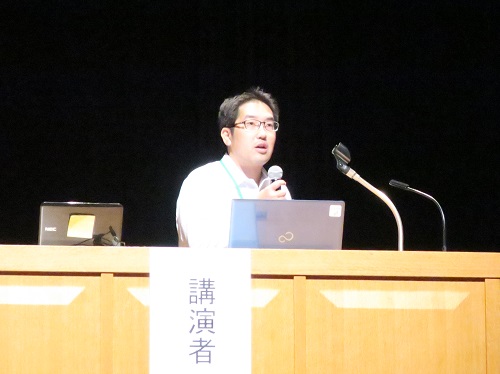
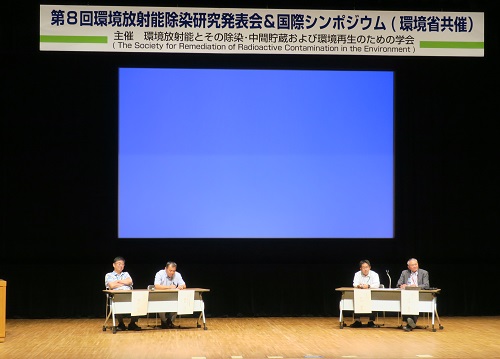

(Top Left)Associate Prof. Wada giving a presentation.
(Top Right)Presenters on discussion the topic given by participants.
(Bottom)Student’s research result was also shown at the poster session.
July 10, 2019 Iwashiro Junior High School visited IER.
Thirty-one students from Iwashiro Junior High School in Nihonmatsu City came to the Institute of Environmental Radioactivity (IER). During their visit to Fukushima University, they attended in a lecture and had a tour around university library as well as IER.
At IER, we introduced the role of the institute along with explanation of our research, and showed them various devices and equipment in the analytical laboratory tour. It was quite impressive that the students answered the questions from staff clearly with their own ideas. We hope that this visit would lead to a discovery for their future.
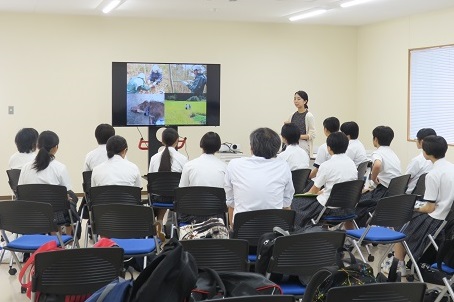
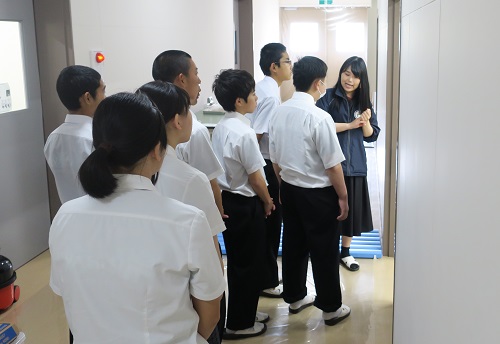
Students listening to explanation on IER activities.
July 6, 2019 The first field survey for IER graduate school students.
Graduate students of Environmental Radioactivity Science Major participated in the first field survey of this academic year. This field survey is offered in a class of "Practicum in Environmental Radioactivity Science" and conducted with a guidance by teacher by turns. This time it was conducted by Project Professor Vasyl Yoschenko and the students are expected to comprehensively learn about the effects of radiation and the fate of radionuclides in forest.
The students entered a cedar forest in Kawamata Town, Fukushima Prefecture, and selected a study area. They measured the density of trees, the diameter of all the trees, air dose rate, and collected branch, litter, and soil samples. They will learn a scientific method of measuring and analyzing those samples in the following classes.
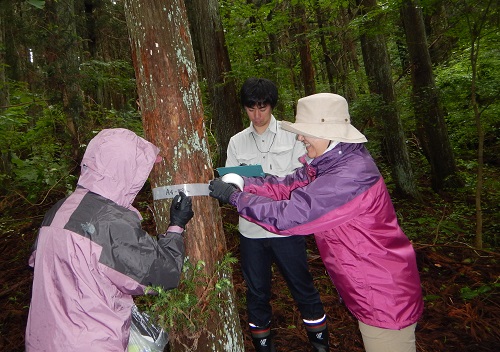

(Left)Students measuring the thickness of a cedar tree
(Right)Professor Yoschenko giving an explanation of the filed survey
July 3, 2019 Associate Prof. Rahman gave a lecture at Fukushima High School.
The IER associate Prof. Ismail Rahman gave a lecture for 26 senior students at Fukushima High School, which is designated as a “Super Science High School (SSH)” by MEXT. As one of the activities as SSH, students have opportunities to have lectures in English by major international visiting researchers from their host institutes.
In the lecture, Prof. Rahman talked about his country, Bangladesh, including its Arsenic contamination which inspired him to become a researcher, then he introduced his current research. After the lecture, students asked various questions on his career and the environmental issues in Bangladesh and even some technical questions on what he studies in his research. Prof Rahman was surprised and happy to know that they have a great interest in chemistry.
He concluded the lecture with a message, ‘We appreciate if some of you pursue careers in science especially in the field of environmental radioactivity. I look forward to working together with you as scientists.’

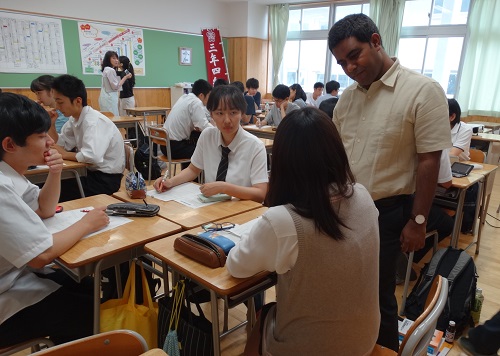
Associate Prof. Rahman giving a lecture to High School Students.
June 28, 2019 We held IER special seminar
| Date | June 28, 2019 |
| Presenter | Minoru Yonezawa (JAEA) |
| Title | "Activities for archiving information resources of Fukushima Daiichi Nuclear Power Station accident" |
Mr. Atsushi Yonezawa, Japan Atomic Energy Agency (JAEA) gave a presentation at the IER special seminar, titled "Activities for archiving information resources of Fukushima Daiichi Nuclear Power Station accident". There were 24 attendee including graduate students of IER and staff of Fukushima University.
Mr. Yonezawa talked about the fact that the public information obtained from the experiences of nuclear power accident and then published on the Internet, have been disappearing over time.
He gave explanations of their activity "Fukushima Nuclear Accident Information Archive (FNAA)" for archiving the information, as well as of why it is necessary.
The utilization and archiving methods of such information would contribute to the IER project of archiving soil samples collected after the accident, and to the research activities of the researchers and students. Things we learned from this seminar will help us with our future activities.
※Click the banner below for more information on their WEB site.
![]()
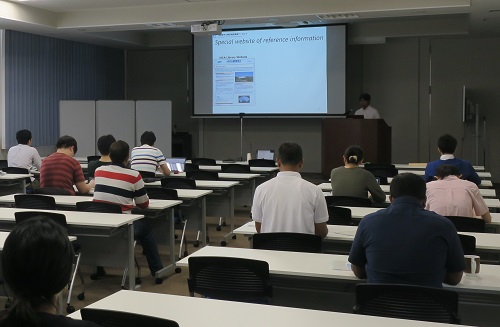

(Left,Right)Mr. Minoru Yonezawa giving a talk.
June 27, 2019 Atami Junior High School Students visited
Nine students of Koriyama City, Atami Junior High School visited the Institute Environmental Radioactivity (IER) as a part of study and observation program provided by Fukushima University (FU), where FU offers campus tour, trial lecture, and lunch at school cafeteria.
After having introduction about the IER activities by a staff, the students had a tour of the analytical laboratory and experienced how human hair looks through the optical microscope and electron microscope.
We hope the event could help them feel closer to a university or research institute.
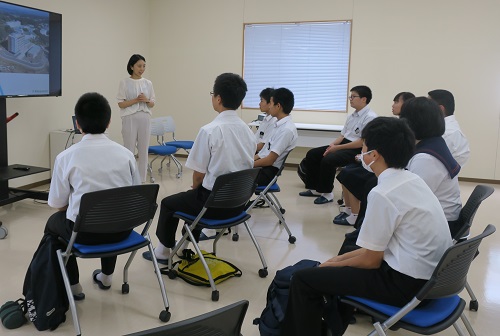
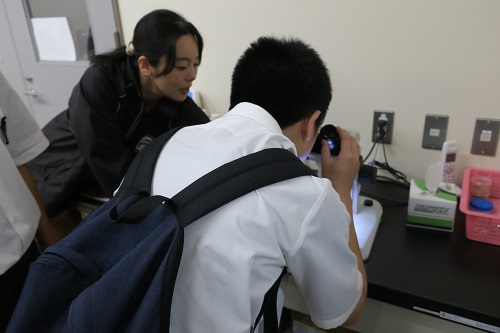
(Left)Introduction of activities
(Right)Looking samples through microscope
June 5, 2019 Students from Colorado State University are visiting Japan.
Three Master students, Cameron Udy, Jian Zhang and Mariah Davis, from Colorado State University (CSU) have come to Japan to conduct research. They will study at IER for two months about the environmental dynamics of radionuclides and radiation effects in ecosystems.
CSU and IER have continued an academic program called “Summer Program” since 2016, where IER accepts students from CSU during the summer vacation of their university. The three students are also the co-researchers of the grant proposals adopted by
the “Environmental Radioactivity Research Network Center (ERNC)”, which began in April. They will conduct research with their host researchers at IER and their achievement will be reported at the end of the fiscal year.
Under the leadership of IER researchers, they will conduct research activities including the field surveys and lab work with focusing on the impact of the nuclear accident on the environment of Fukushima, they also plan to share their experiences in the occasion of seminars and meetings.
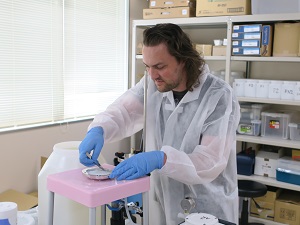

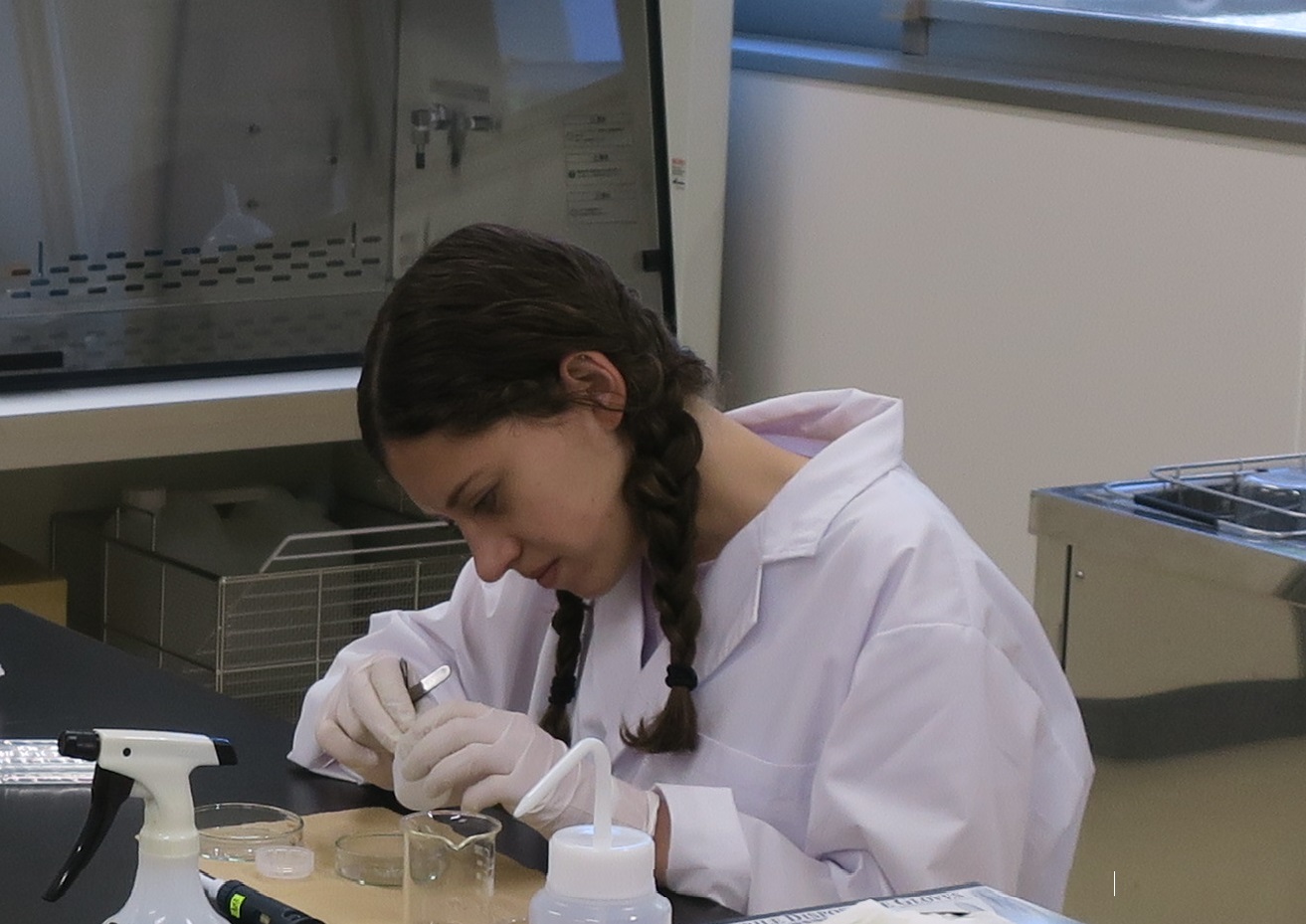
(Top Left) Cameron Udy (Top Right) Jian Zhang (Left) Mariah Davis
May 27, 2019 We held IER special seminar
| Date | May 27, 2019 |
| Presenter | Professor Carmel Mothersill (McMaster University) |
| Title | "Radiobiology meets Radioecology; understanding low radiation dose effects in the environment" |
Two Professors from McMaster University (Mac) in Canada visited Fukushima University (FU), and Professor Carmel Mothersill gave a presentation at IER. Twenty-three researchers, mainly in the field of ecology, participated.
Mac and FU have concluded the agreement on academic exchange since 2017. Professors Carmel Mothersill and Colin Seymour are interested in a joint research with IER researchers. Professor Nanba (SSS, Fukushima University), as a potential collaborator, gave them a tour of the IER including analytical facility and equipment followed by a discussion toward the future.
They also discussed about the possibilities to deepen the academic exchange between two universities, such as the students exchange through the Fukushima Ambassadors Program (FAP), an international exchange program planned by FU.
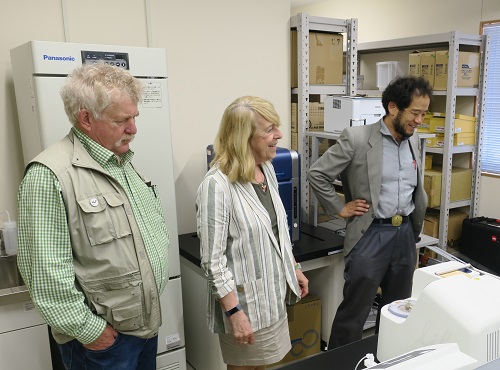
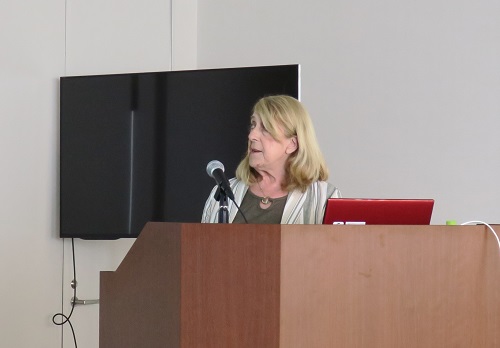
(Left)
Professor Carmel Mothersill, Professor Colin Seymour having a tour at analytical laboratory guided by Prof. Nanba.
(Right)
Professor Carmel Mothersill giving a presentation.
May 23, 2019 We held SATREPS symposium
“Agriculture and Hydrological researches in ChEZ and Fukushima”
| Date | May 23, 2019 |
| Presenter | Professor Hirofumi Tsukada Senior Assistant Professor Yoshifumi Wakiyama Project Professor Vasyl Yoschenko Doctor Demianovych Volodymyr (State Specialized Enterprise "Ecocenter") Professor Kashparov Valerii (Ukrainian Institute of Agricultural Radiology) Project Professor Mark Zheleznyak |
| 演題 | 1. “General Introduction of IER and Research Activities on Agricultural Issues"(Tsukada)
2. “Hydrological Studies of Rivers in Fukushima"(Wakiyama) 3. “Forest Studies in Fukushima"(Yoschenko) 4. “River Studies in ChEZ" (Volodymyr) 5. “Researches of Radionuclides in Soil in ChEZ”(Valerii) 6. “Overview of the IER modeling results for the rivers /reservoirs and coastal areas at Fukushima Prefecture”(Zheleznyak) |
We invited the SATREPS project researchers from Ukraine and held a symposium titled "Agriculture and Hydrological researches in ChEZ and Fukushima". There were 43 participants, including the students and researches from IER, faculty members of Symbiotic Systems Science and Food and Agricultural Sciences at Fukushima University, as well as people from other institutes.
Six researchers, including 2 from Ukraine, presented their research results on the effects of the radiation released into the environment by the nuclear accident on crops, forest, rivers, and soil. After each valuable report on the current situation of Chernobyl and Fukushima, an active exchange of opinions took place. The symposium was meaningful for the further development of joint research in the SATREPS project.
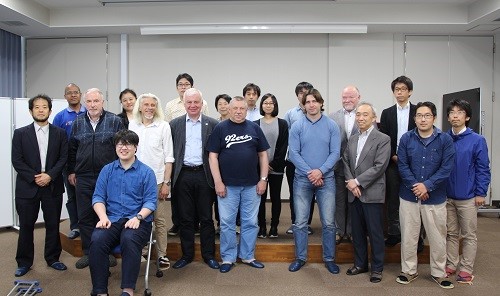
Prof. Kashparov Valerii, (front, fourth from the left) Dr. Kedranovskyi Mykola, (front, center) and Dr. Demianovych Volodymyr (fourth from the right).
May 22, 2019 Ukrainian researchers visited Fukushima
The SATREPS project is now in its third year since the project started. In order to share the research results so far and to aim further studies in future, we invited three project researchers from Ukraine.
Ukrainian researchers and IER members conducted a tour of the Fukushima nuclear power plants, some research institutes, and disaster areas to observe reconstruction activities. Profssor Kashparov Valerii (Ukrainian Institute of Agricultural Radiology), Doctor Kedranovskyi Mykola (State Specialized Enterprise "Ecocenter": hereinafter called "Ecocenter"), Doctor Demianovych Volodymyr ("Ecocenter"), and from IER, Professor Kenji Nanba (SSS, Fukushima University), Project Professor Mark Zheleznyak, Project researcher Yasunori Igarashi, and Hiroshi Kataoka (IER, Ukraine office) participated.
During the TEPCO tour, the staff explained the situation of Dai-ichi and Daini Nuclear Power Plant when the earthquake occurred, the post-accident activities, and the current situation. The researchers listened eagerly and commented, "The information has been available about Fukushima Dai-ichi Nuclear Power Plant, but not much about Fukushima Daini Nuclear Power Plant so far. It was interesting to see inside of the nuclear power plant." It is expected that their visit to Japan will lead to a further achievement of the research.

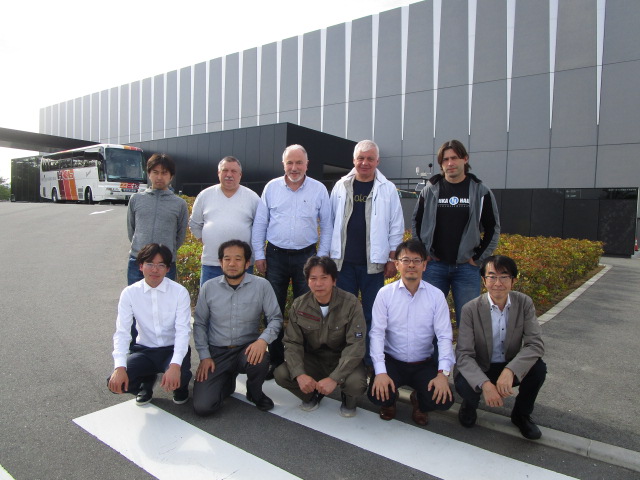
(Left)We looked around the inside of the Fukushima Daini Nuclear Power Plant
(Right)We participated the tour for Fukushima Dai-ichi Nuclear Power Plant
May 14, 2019 We held IER special seminar
| Date | May 14, 2019 |
| Presenter | ・Project Professor Vasyl Yoschenko ・Professor Geras’kin Stanislav, Head of laboratory, Russian Institute of Radiology and Agroecology ・Professor Horemans Nele, Head of Unit, Belgian Nuclear Research Centre SCK-CEN ・Doctor Yoshito Watanabe, Senior researcher, National Institute of Radiological Sciences |
| Title | 1."Radiation effects on coniferous plant species in Chernobyl and Fukushima"
(Vasyl)
2. "Biological effects of long-term chronic exposure. A case study on Scots pine populations" (Geras’kin) 3. "Current evidence for a role of epigenetic mechanisms in response to ionizing radiation in an ecotoxicological context" (Horemans) 4. "Comparative studies between field and irradiation experiments for elucidation of biological effects of radiation on the forest" (Watanabe) |
We held a special IER seminar presented by four researchers who study the radiation effects on forests and plants. Thirty one researchers and students from IER and other faculties of Fukushima University attended it.
The IER seminar was held in conjunction with the kickoff meeting of the bilateral programs, which started in April 2019. Project Professor Vasyl Yoschenko has two bilateral projects adopted by JSPS (Japan Society for the Promotion of Science). The one is between JSPS and FWO (Research
Foundation Flanders) in Belgium, and the other is JSPS and RFBR (Russian Basic Science Foundation) in Russia. Principal investigator of each country, Prof. Horemans Nele and Prof. Geras’kin Stanislav, as well as Dr. Yoshito Watanabe, who is a collaborative researcher of Japan side visited IER and gave presentations on their own research.
These two joint research projects will be continued for two years. They have conducted the field survey inside the difficult-to-return zones in Fukushima during their stay. The study is also expected to contribute to the local residents as their research topic, the radiation effects on forests and plants, is familiar to them.

Prof. Geras’kin Stanislav, (second from the right) Prof. Horemans Nele,(third from the right) and Dr. Yoshito Watanabe (third from the left) and Prof. Vasyl Yoschienko (fourth from the left)
April 17, 2019 We held IER special seminar
| Date | April 17, 2019 |
| Presenter | Professor Izmail Kantarzhi (Moscow State University of Civil Engineering) |
We held IER special seminar presented by Prof. Izmail Kantarzhi from National Research Moscow State University of Civil Engineering (NRU MGSU). 14 researchers and students at IER attended it.
NRU MGSU was established in 1921, now has more than 50 departments and 18000 students. In 2010, it was designated as “National Research University” by the Government of the Russian Federation.
Since then the university has been taking an important role as an advanced institute in this area where further researches are expected such as science, technology, equipment, branches of economy, social sphere, development and introduction in manufacture of high technologies. Prof. Izmail has been involved in research and education in ocean/river hydraulics and coastal engineering at this university.
This seminar was realized because Prof. Izmail, who had been in Japan to participate in a symposium, visited our institute to discuss the possibility of collaborative research between NRU MGSU and Fukushima University in the future.
Having started with the introduction of NRU MGSU, Prof. Izmail talked about the projects he had conducted and the participants listened to his lecture attentively. It is expected that future collaborations and active two-way communication in research and education between the two universities will be realized.
Professor Izmail Kantarzhi(third from the right) and IER professors.
April 4, 2019 The eight graduate school students were admitted.
The entrance ceremony of the Fukushima University was held on 4th April. The eight graduate school students were admitted to the Environmental Radioactivity Science Major at Fukushima University Graduate School of Symbiotic Systems Science and Technology, which belongs to the institute of environmental radioactivity (IER).
The major was newly created as a part of Graduate School of Symbiotic Systems Science and Technology, to develop individuals who can contribute to solving the problems and developing academic studies in the field of environmental radioactivity with a mid- to long-term perspective.
It is expected that the students who have started their 1st grade here in the major will play a great role in this field in future.
(left)Guidance for the new students.
(right)Group photo with eight the new students and IER professors.